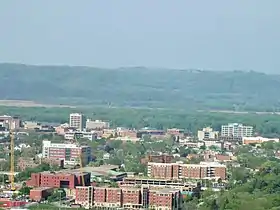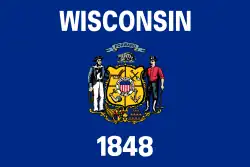La Crosse–Onalaska
The La Crosse–Onalaska Metropolitan Statistical Area, as defined by the United States Census Bureau, is an area consisting of La Crosse County, Wisconsin and Houston County, Minnesota, anchored by the cities of La Crosse and Onalaska. The area is part of what is commonly referred to as the Coulee Region or 7 Rivers Region. As of the 2020 census, the MSA had a population of 139,627, and in 2022 estimates placed the total population at 139,094.[1]
La Crosse-Onalaska | |
|---|---|
| La Crosse-Onalaska, WI-MN Metropolitan Statistical Area | |
| Country | |
| States | |
| Largest city | La Crosse, WI |
| Other cities | Onalaska, WI Holmen, WI La Crescent, MN |
| Area | |
| • Metropolitan statistical area | 1,003.8 sq mi (2,600 km2) |
| Highest elevation | 1,410 ft (430 m) |
| Lowest elevation | 626 ft (191 m) |
| Population (2020) | |
| • Metropolitan statistical area | 139,627 |
| • Estimate (2022)[1] | 139,094 |
| • Rank | 299th in the U.S. |
| • Urban | 98,872 (314th) |
| Time zone | UTC-6 (CST) |
| • Summer (DST) | UTC-5 (CDT) |
| Area code(s) | 608 and 507 |
| Interstates | |
| Public Transit | La Crosse MTU SMRT |
| Website | engagegreaterlacrosse.org |
Counties
Communities
Places with more than 50,000 inhabitants
- La Crosse, WI (Principal city)
Places with 5,000 to 20,000 inhabitants
Places with 1,000 to 5,000 inhabitants
Places with fewer than 1,000 inhabitants
Population
| Census | Pop. | Note | %± |
|---|---|---|---|
| 1860 | 18,831 | — | |
| 1870 | 35,233 | 87.1% | |
| 1880 | 43,405 | 23.2% | |
| 1890 | 53,454 | 23.2% | |
| 1900 | 58,397 | 9.2% | |
| 1910 | 58,293 | −0.2% | |
| 1920 | 58,368 | 0.1% | |
| 1930 | 68,300 | 17.0% | |
| 1940 | 74,388 | 8.9% | |
| 1950 | 82,022 | 10.3% | |
| 1960 | 89,053 | 8.6% | |
| 1970 | 98,024 | 10.1% | |
| 1980 | 109,438 | 11.6% | |
| 1990 | 116,401 | 6.4% | |
| 2000 | 126,838 | 9.0% | |
| 2010 | 133,665 | 5.4% | |
| 2020 | 139,627 | 4.5% | |
| 2022 (est.) | 139,094 | [1] | −0.4% |
| U.S. Decennial Census[2] 2020 Census | |||
Cities
Primary
Onalaska was promoted as a principal city of the MSA when the Office of Management and Budget revised the definitions of metropolitan statistical areas in 2013.[3]
See also
References
- "Metropolitan and Micropolitan Statistical Areas Population Totals and Components of Change: 2020-20212". United States Census Bureau. United States Census Bureau. Retrieved May 26, 2023.
- "U.S. Decennial Census". Census.gov. Archived from the original on May 7, 2015. Retrieved May 19, 2013.
- "Revised Delineations of Metropolitan Statistical Areas, Micropolitan Statistical Areas, and Combined Statistical Areas, and Guidance on Uses of the Delineations of These Areas" (pdf). Office of Management and Budget. February 28, 2013. Archived (PDF) from the original on February 7, 2017. Retrieved February 4, 2016.
External links
This article is issued from Wikipedia. The text is licensed under Creative Commons - Attribution - Sharealike. Additional terms may apply for the media files.



